Page 106 of 623
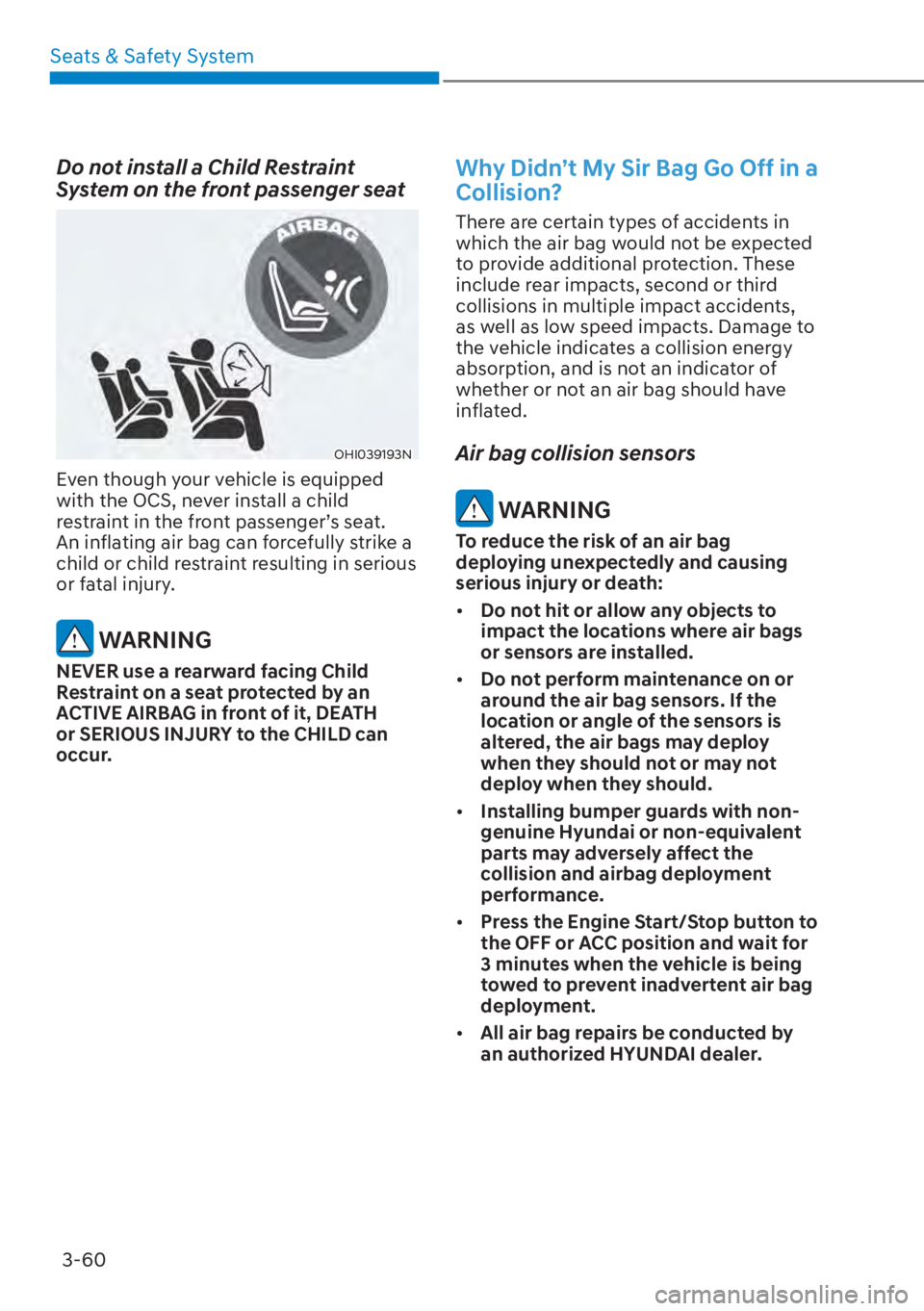
Seats & Safety System3-60
Do not install a Child Restraint
System on the front passenger seat
OHI039193N
Even though your vehicle is equipped
with the OCS, never install a child
restraint in the front passenger’s seat.
An inflating air bag can forcefully strike a
child or child restraint resulting in serious
or fatal injury.
WARNING
NEVER use a rearward facing Child
Restraint on a seat protected by an
ACTIVE AIRBAG in front of it, DEATH
or SERIOUS INJURY to the CHILD can
occur.
Why Didn’t My Sir Bag Go Off in a
Collision?
There are certain types of accidents in
which the air bag would not be expected
to provide additional protection. These
include rear impacts, second or third
collisions in multiple impact accidents,
as well as low speed impacts. Damage to
the vehicle indicates a collision energy
absorption, and is not an indicator of
whether or not an air bag should have
inflated.
Air bag collision sensors
WARNING
To reduce the risk of an air bag
deploying unexpectedly and causing
serious injury or death:
�[�� Do not hit or allow any objects to
impact the locations where air bags
or sensors are installed.
�[�� Do not perform maintenance on or
around the air bag sensors. If the
location or angle of the sensors is
altered, the air bags may deploy
when they should not or may not
deploy when they should.
�[�� Installing bumper guards with non-
genuine Hyundai or non-equivalent
parts may adversely affect the
collision and airbag deployment
performance.
�[�� Press the Engine Start/Stop button to
the OFF or ACC position and wait for
3 minutes when the vehicle is being
towed to prevent inadvertent air bag
deployment.
�[�� All air bag repairs be conducted by
an authorized HYUNDAI dealer.
Page 107 of 623
3-61
03
1. SRS control module / Rollover sensor (if equipped)
2. Front impact sensor
3. Side impact sensor (Pressure) 4. Side impact sensor (Acceleration)
5. Side impact sensor (Acceleration)
OTMH030001/OTM030010/OTM030011/OTM030035/OTM030036/OTMPH031012N
5
Page 108 of 623
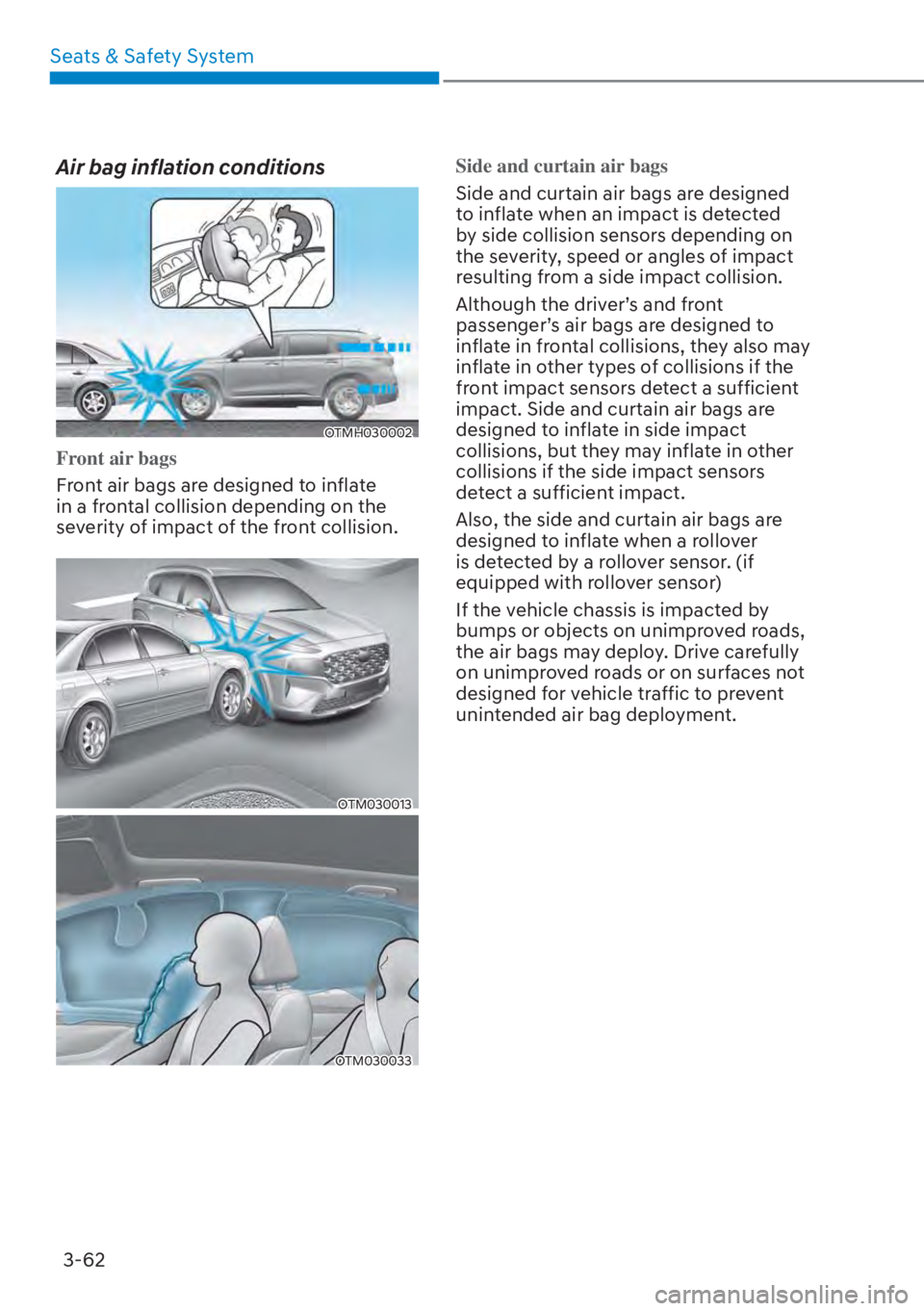
Seats & Safety System3-62
Air bag inflation conditions
OTMH030002
Front air bags
Front air bags are designed to inflate
in a fr
ontal collision depending on the
severity of impact of the front collision.
OTM030013
OTM030033
Side and curtain air bags
Side and curtain air bags are designed
t
o inflate when an impact is detected
by side collision sensors depending on
the severity, speed or angles of impact
resulting from a side impact collision.
Although the driver’s and front
passenger’s air bags are designed to
inflate in frontal collisions, they also may
inflate in other types of collisions if the
front impact sensors detect a sufficient
impact. Side and curtain air bags are
designed to inflate in side impact
collisions, but they may inflate in other
collisions if the side impact sensors
detect a sufficient impact.
Also, the side and curtain air bags are
designed to inflate when a rollover
is detected by a rollover sensor. (if
equipped with rollover sensor)
If the vehicle chassis is impacted by
bumps or objects on unimproved roads,
the air bags may deploy. Drive carefully
on unimproved roads or on surfaces not
designed for vehicle traffic to prevent
unintended air bag deployment.
Page 109 of 623
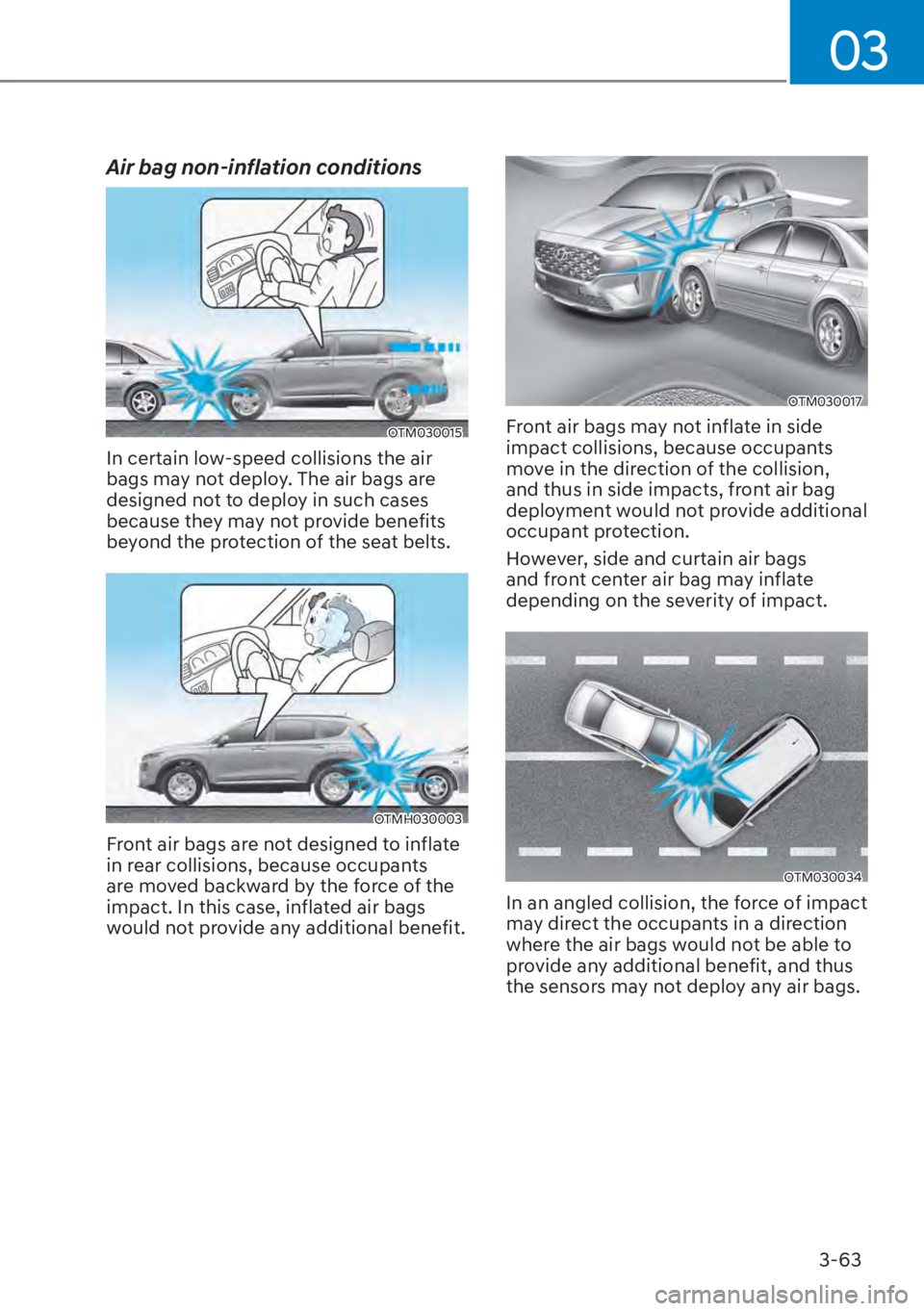
03
3-63
Air bag non-inflation conditions
OTM030015
In certain low-speed collisions the air
bags may not deploy. The air bags are
designed not to deploy in such cases
because they may not provide benefits
beyond the protection of the seat belts.
OTMH030003
Front air bags are not designed to inflate
in rear collisions, because occupants
are moved backward by the force of the
impact. In this case, inflated air bags
would not provide any additional benefit.
OTM030017
Front air bags may not inflate in side
impact collisions, because occupants
move in the direction of the collision,
and thus in side impacts, front air bag
deployment would not provide additional
occupant protection.
However, side and curtain air bags
and front center air bag may inflate
depending on the severity of impact.
OTM030034
In an angled collision, the force of impact
may direct the occupants in a direction
where the air bags would not be able to
provide any additional benefit, and thus
the sensors may not deploy any air bags.
Page 110 of 623
Seats & Safety System3-64
OTM030018
Just before impact, drivers often brake
heavily. Such heavy braking lowers the
front portion of the vehicle causing it
to “ride” under a vehicle with a higher
ground clearance. Air bags may not
inflate in this “underride” situation
because deceleration forces that are
detected by sensors may be significantly
reduced by such “underride” collisions.
OTM030041
Front air bags may not inflate in
rollover accidents because front air bag
deployment would not provide additional
occupant protection.
OTMH030004
Air bags may not inflate if the vehicle
collides with objects such as utility poles
or trees, where the point of impact is
concentrated and the collision energy is
absorbed by the vehicle structure.
Page 167 of 623
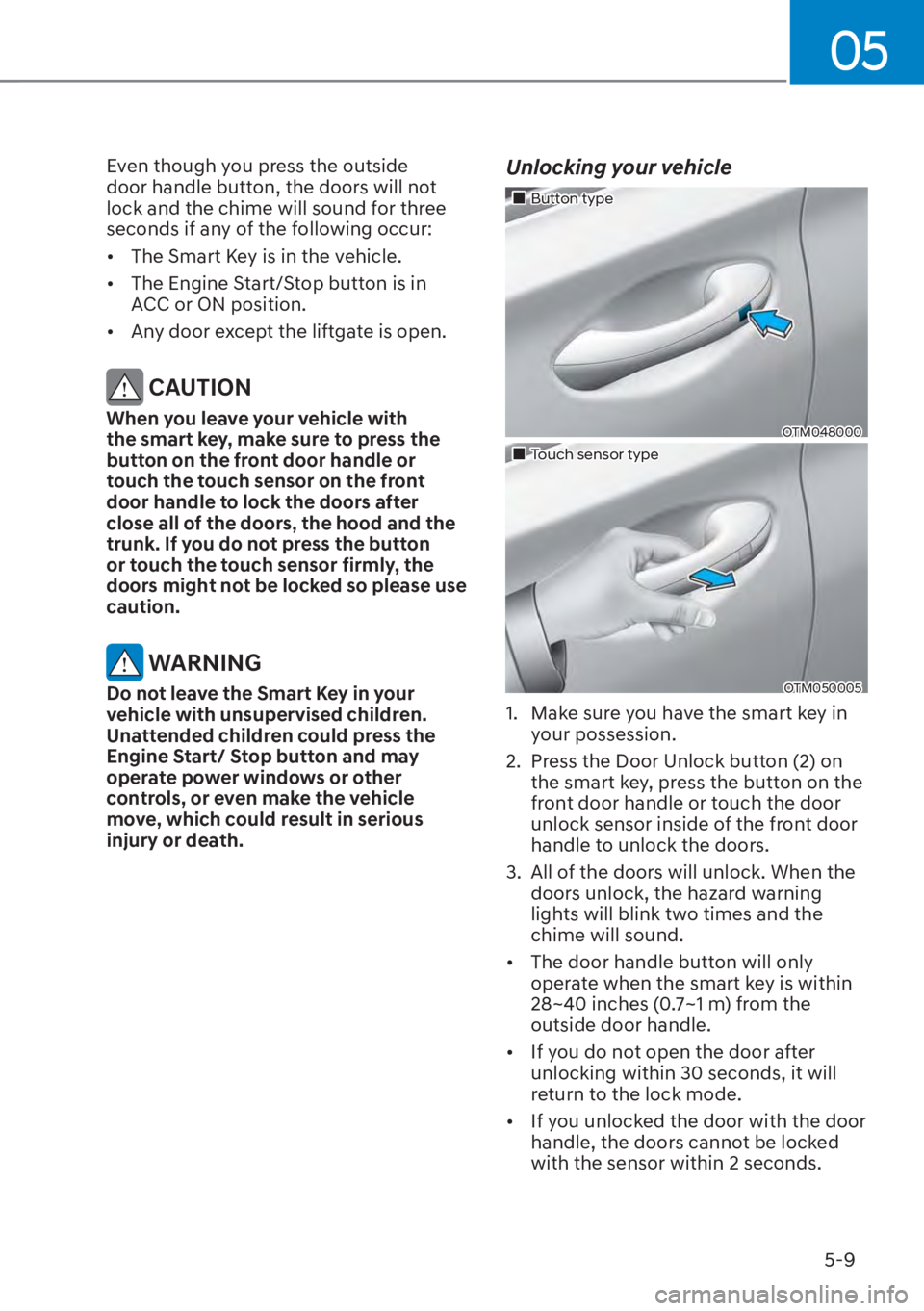
05
5-9
Even though you press the outside
door handle button, the doors will not
lock and the chime will sound for three
seconds if any of the following occur:
�[��The Smart Key is in the vehicle.
�[�� The Engine Start/Stop button is in
ACC or ON position.
�[�� Any door except the liftgate is open.
CAUTION
When you leave your vehicle with
the smart key, make sure to press the
button on the front door handle or
touch the touch sensor on the front
door handle to lock the doors after
close all of the doors, the hood and the
trunk. If you do not press the button
or touch the touch sensor firmly, the
doors might not be locked so please use
caution.
WARNING
Do not leave the Smart Key in your
vehicle with unsupervised children.
Unattended children could press the
Engine Start/ Stop button and may
operate power windows or other
controls, or even make the vehicle
move, which could result in serious
injury or death.
Unlocking your vehicle
���„Button type
OTM048000
���„Touch sensor type
OTM050005
1. Make sure you have the smart key in
your possession.
2. Press the Door Unlock button (2) on the smart key, press the button on the
front door handle or touch the door
unlock sensor inside of the front door
handle to unlock the doors.
3. All of the doors will unlock. When the doors unlock, the hazard warning
lights will blink two times and the
chime will sound.
�[�� The door handle button will only
operate when the smart key is within
28~40 inches (0.7~1 m) from the
outside door handle.
�[�� If you do not open the door after
unlocking within 30 seconds, it will
return to the lock mode.
�[�� If you unlocked the door with the door
handle, the doors cannot be locked
with the sensor within 2 seconds.
Page 195 of 623
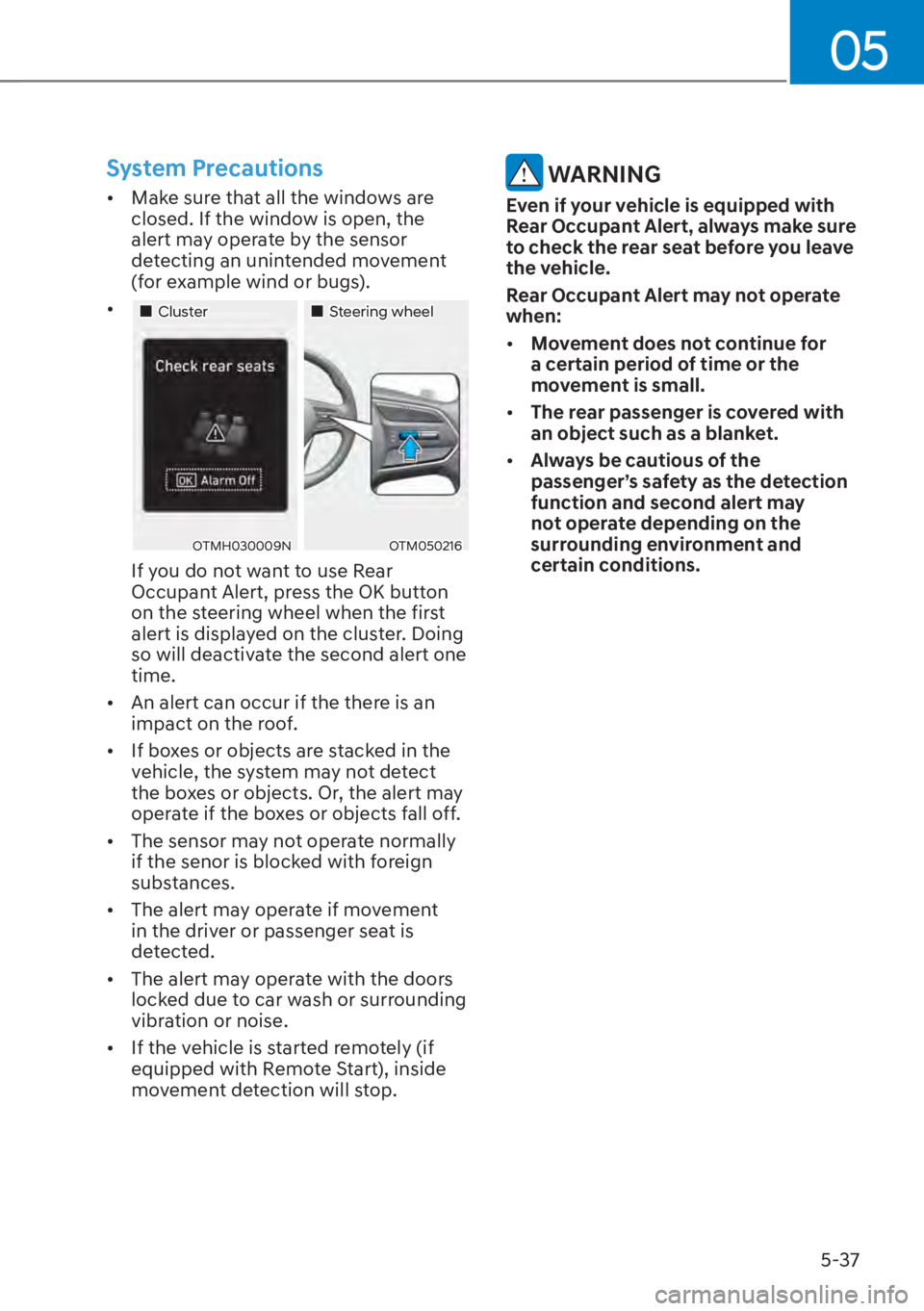
05
5-37
System Precautions
�[��Make sure that all the windows are
closed. If the window is open, the
alert may operate by the sensor
detecting an unintended movement
(for example wind or bugs).
�[�� ���„Cluster ���„Steering wheel
OTMH030009NOTM050216
If you do not want to use Rear
Occupant Alert, press the OK button
on the steering wheel when the first
alert is displayed on the cluster. Doing
so will deactivate the second alert one
time.
�[�� An alert can occur if the there is an
impact on the roof.
�[�� If boxes or objects are stacked in the
vehicle, the system may not detect
the boxes or objects. Or, the alert may
operate if the boxes or objects fall off.
�[�� The sensor may not operate normally
if the senor is blocked with foreign
substances.
�[�� The alert may operate if movement
in the driver or passenger seat is
detected.
�[�� The alert may operate with the doors
locked due to car wash or surrounding
vibration or noise.
�[�� If the vehicle is started remotely (if
equipped with Remote Start), inside
movement detection will stop.
WARNING
Even if your vehicle is equipped with
Rear Occupant Alert, always make sure
to check the rear seat before you leave
the vehicle.
Rear Occupant Alert may not operate
when:
�[��Movement does not continue for
a certain period of time or the
movement is small.
�[�� The rear passenger is covered with
an object such as a blanket.
�[�� Always be cautious of the
passenger’s safety as the detection
function and second alert may
not operate depending on the
surrounding environment and
certain conditions.
Page 203 of 623
![HYUNDAI SANTA FE HYBRID 2023 Owners Manual 05
5-45
Electric Chromic Mirror (ECM)
(if equipped)
OTM050019[A] : Indicator
Some vehicles come equipped with an
electrochromic mirror that helps control
glare while driving at night or under low HYUNDAI SANTA FE HYBRID 2023 Owners Manual 05
5-45
Electric Chromic Mirror (ECM)
(if equipped)
OTM050019[A] : Indicator
Some vehicles come equipped with an
electrochromic mirror that helps control
glare while driving at night or under low](/manual-img/35/58886/w960_58886-202.png)
05
5-45
Electric Chromic Mirror (ECM)
(if equipped)
OTM050019[A] : Indicator
Some vehicles come equipped with an
electrochromic mirror that helps control
glare while driving at night or under low
light driving conditions.
When the engine is running, the glare is
automatically controlled by the sensor
mounted in the rearview mirror. The
sensor detects the light level around the
vehicle, and automatically adjusts to
control the headlamp glare from vehicles
behind you.
Whenever the the gear is shifted to R
(Reverse), the mirror will automatically
go to the brightest setting in order to
improve the driver’s view behind the
vehicle.
Electrochromic mirror (ECM) with
HomeLink® system (if equipped)
Your vehicle may be equipped with
a Gentex Automatic-Dimming Mirror
with an Integrated HomeLink® Wireless
Control System.
During nighttime driving, this feature
will automatically detect and reduce
rearview mirror glare. The HomeLink®
Universal Transceiver allows you to
activate your garage door(s), electric
gate, home lighting, etc.
OTMA050002
(1) HomeLink Channel 1
(2) HomeLink Channel 2
(3) HomeLink Channel 3
(4) Garage Door Opener Status Indicator: Closing or Closed
(5) HomeLink Operation Indicator
(6) Garage Door Opener Status Indicator: Opening or Opened
(7) HomeLink User Interface Indicator